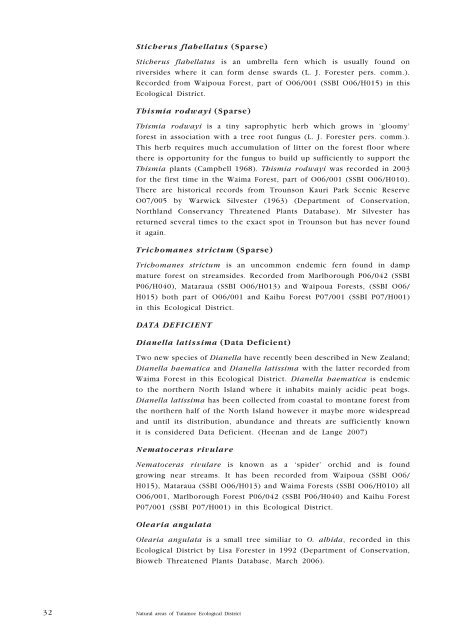Natural areas of Tutamoe Ecological District (3. Ecological character)
Natural areas of Tutamoe Ecological District (3. Ecological character)
Natural areas of Tutamoe Ecological District (3. Ecological character)
You also want an ePaper? Increase the reach of your titles
YUMPU automatically turns print PDFs into web optimized ePapers that Google loves.
Sticherus flabellatus (Sparse)<br />
Sticherus flabellatus is an umbrella fern which is usually found on<br />
riversides where it can form dense swards (L. J. Forester pers. comm.).<br />
Recorded from Waipoua Forest, part <strong>of</strong> O06/001 (SSBI O06/H015) in this<br />
<strong>Ecological</strong> <strong>District</strong>.<br />
thismia rodwayi (Sparse)<br />
Thismia rodwayi is a tiny saprophytic herb which grows in ‘gloomy’<br />
forest in association with a tree root fungus (L. J. Forester pers. comm.).<br />
This herb requires much accumulation <strong>of</strong> litter on the forest floor where<br />
there is opportunity for the fungus to build up sufficiently to support the<br />
Thismia plants (Campbell 1968). Thismia rodwayi was recorded in 2003<br />
for the first time in the Waima Forest, part <strong>of</strong> O06/001 (SSBI O06/H010).<br />
There are historical records from Trounson Kauri Park Scenic Reserve<br />
O07/005 by Warwick Silvester (1963) (Department <strong>of</strong> Conservation,<br />
Northland Conservancy Threatened Plants Database). Mr Silvester has<br />
returned several times to the exact spot in Trounson but has never found<br />
it again.<br />
trichomanes strictum (Sparse)<br />
Trichomanes strictum is an uncommon endemic fern found in damp<br />
mature forest on streamsides. Recorded from Marlborough P06/042 (SSBI<br />
P06/H040), Mataraua (SSBI O06/H013) and Waipoua Forests, (SSBI O06/<br />
H015) both part <strong>of</strong> O06/001 and Kaihu Forest P07/001 (SSBI P07/H001)<br />
in this <strong>Ecological</strong> <strong>District</strong>.<br />
dAtA deFIcIent<br />
dianella latissima (Data Deficient)<br />
Two new species <strong>of</strong> Dianella have recently been described in New Zealand;<br />
Dianella haematica and Dianella latissima with the latter recorded from<br />
Waima Forest in this <strong>Ecological</strong> <strong>District</strong>. Dianella haematica is endemic<br />
to the northern North Island where it inhabits mainly acidic peat bogs.<br />
Dianella latissima has been collected from coastal to montane forest from<br />
the northern half <strong>of</strong> the North Island however it maybe more widespread<br />
and until its distribution, abundance and threats are sufficiently known<br />
it is considered Data Deficient. (Heenan and de Lange 2007)<br />
nematoceras rivulare<br />
Nematoceras rivulare is known as a ‘spider’ orchid and is found<br />
growing near streams. It has been recorded from Waipoua (SSBI O06/<br />
H015), Mataraua (SSBI O06/H013) and Waima Forests (SSBI O06/H010) all<br />
O06/001, Marlborough Forest P06/042 (SSBI P06/H040) and Kaihu Forest<br />
P07/001 (SSBI P07/H001) in this <strong>Ecological</strong> <strong>District</strong>.<br />
Olearia angulata<br />
Olearia angulata is a small tree similiar to O. albida, recorded in this<br />
<strong>Ecological</strong> <strong>District</strong> by Lisa Forester in 1992 (Department <strong>of</strong> Conservation,<br />
Bioweb Threatened Plants Database, March 2006).<br />
32 <strong>Natural</strong> <strong>areas</strong> <strong>of</strong> <strong>Tutamoe</strong> <strong>Ecological</strong> <strong>District</strong>

















